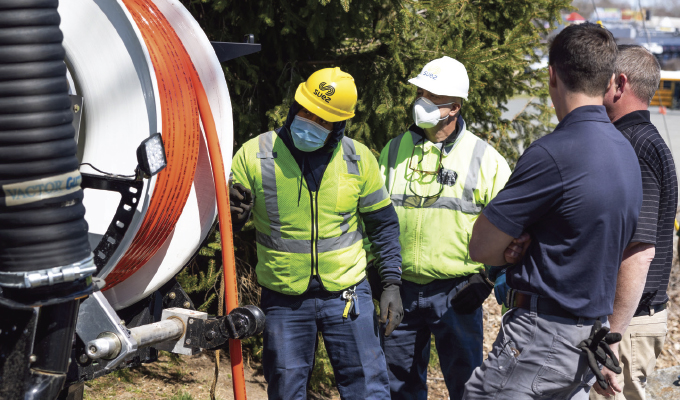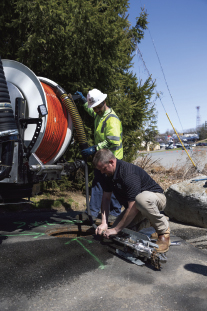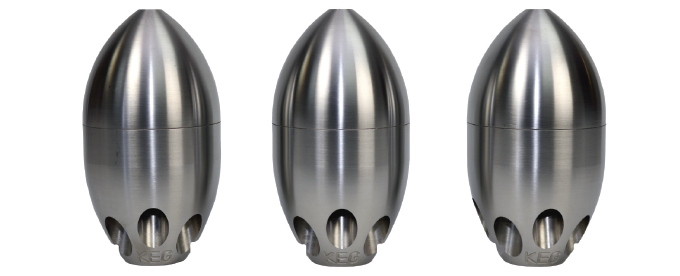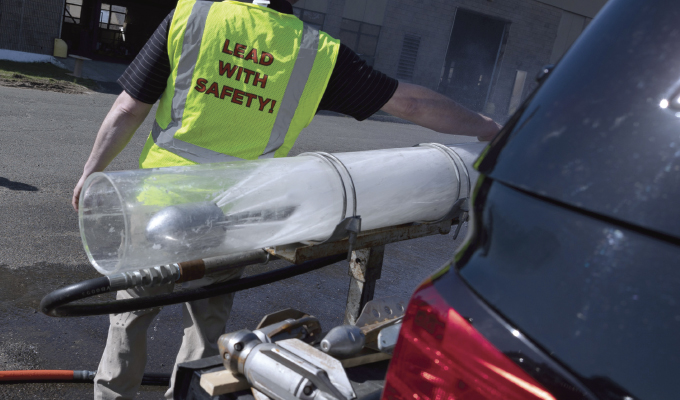Municipalities must safely clean and maintain many miles of sewer line annually to eliminate blockages and prevent sanitary sewer overflows, which are regulated by the Environmental Protection Agency (EPA). However, the use of high-pressure equipment in underground sewers can be dangerous unless operators are well trained and fully understand the hazards.
Understanding and correcting some of the most common operator mistakes in sewer cleaning can go a long way toward keeping them safe. Therefore, safety expert Dan Story, operations manager at KEG Technologies, who has instructed operators for decades, provides ten tried-and-true sewer cleaning safety tips that address the most common errors that he has observed. The Spartanburg, South Carolina-based company is a manufacturer of sewer and storm line products including Tier 1 to Tier 3 nozzles, chain cutters, floor cleaners, and camera nozzle systems.
As a national trainer of best-practice techniques, the company is a member of NASSCO, the National Association of Sewer Service Companies, and its Tier 3 High Efficiency nozzles, such as the Torpedo, Royal, and OMG, provide up to 98 percent efficiency.
1. PROPERLY SET UP THE AREA AROUND THE SEWER VACUUM TRUCK TO ENSURE OPERATOR SAFETY IN STREET TRAFFIC
“To start sewer cleaning, when you park the vacuum truck in the middle of the road, you need to block off the traffic so it can pass in a safe manner. Set safety cones in front and behind the work zone and make sure the hazard flasher lights are functioning correctly,” says Story.
2. KEEP EQUIPMENT NOISE LEVELS LOW ENOUGH TO HEAR TRAFFIC
Revving the sewer truck engine and running its vacuum pump can be noisy. So, Story advises keeping RPMs low enough so operators can hear and avoid approaching vehicles and converse with co-workers as needed.
One way to lower sewer vacuum truck RPMs during engine operation is by only using the vacuum when needed and allowing the water to pass through as the solids remain.
“You can put the nozzle in the bottom of the sewer pipe and let the water run around it. The solids remain to vacuum as needed. You do not need to run continuously high RPMs,” says Story.
Another method is using more efficient nozzles, which enable sewer cleaning with lower pressure water, reducing engine RPMs.
3. UNDERSTAND HOW YOUR SPECIFIC SEWER TRUCK BOOM OPERATES
There are differences in how every sewer truck manufacturer configures, deploys, and extends the booms that control the vacuum hose. Some deploy rapidly, some articulate, some telescope. Operators must understand these differences before operating a boom in the field around their co-workers.
“Because you may go out in different vehicles from day to day with different crew members, it is important that you understand your boom equipment. For everyone’s safety, do not rush the job because the boom can cause injuries if it is not used with full understanding and control,” says Story.
4. USE PERSONAL PROTECTIVE EQUIPMENT (PPE) AND PRACTICE GOOD HYGIENE
“Protect your hands and feet with waterproof gloves and work boots. Protect your eyes with goggles or a face shield. Of course, protect your head with a hard hat to avoid injury from a swinging boom or a falling object,” says Story.
When cleaning sewers, operators exposed to sewage or human waste may be at increased risk of becoming ill from waterborne diseases. To reduce this risk and protect against illness, operators should wash hands with soap and water immediately after cleaning sewers before eating or drinking. Avoid touching the face, mouth, eyes, and nose while handling sewage, and cover any open cuts, sores, or wounds with clean, dry bandages.
In addition, Story points out that the CDC advises vaccination against Hepatitis A and B and other contagious diseases that could put operators at risk when exposed to sewage or human waste. The CDC, in fact, also recommends vaccinations for tetanus, polio, and typhoid fever in these environments.

5. OPEN THE UPSTREAM SEWER MANHOLE FIRST
In underground sewers, operators can be at risk from toxic inhalation. High concentrations of methane in enclosed areas can lead to hazards as large amounts of methane decrease the amount of oxygen in the air. Oxygen deficiency can cause headache, nausea, dizziness, and even unconsciousness.
Story says that one of the first things that operators must do is open the upstream manhole as a precaution to enable drawing in clean air.
“For safety in sewer pipe, the first thing you always want to do is open your upstream sewer manhole. That will allow the system to draw in fresh air. On the other hand, if the air were to be drawn directly from the homes, it could fill them with sewer gas, which is unsafe and unpleasant for homeowners,” says Story.
6. TO AVOID INJURY, DO NOT START HYDRO JETTING OUTSIDE A PIPE
With hydro jetting, sewer cleaning nozzles are designed to direct water at exceedingly high rates of pressure. For typical cleaning, 1,000 to 1,500 PSI is normal. To remove a blockage, pressures as high as 5,000 PSI may be reached.
“Sewer cleaning nozzles at extremely high pressures should only be used in a pipe,” cautions Story. “If a nozzle is used outside of a pipe, it can whip around like a fire hose. I have seen sewer nozzles and hose go up and wrap around telephone wires. I have seen nozzles over 60 feet in the air.”

7. USE A HOSE WITH A ROBUST SAFETY FACTOR TO PREVENT BURSTING
Since hose and nozzle pressures can be so high, it is important to utilize only robust hose of sufficient strength to ensure safe use over time, according to Story.
“Most operators and municipalities overlook the possibility of burst hoses. However, hose is gradually cut going in and out of sewer pipe. The braided nylon weave remains, but every layer that is cut reduces hose strength and the corresponding PSI that can be run,” says Story.
8. PROPERLY SIZE THE NOZZLE-TO-HOSE CONNECTION TO PREVENT NOZZLE “RICOCHET”
If the nozzle-to-hose connection is not sized properly, it can lead to a dangerous, high-pressure “ricochet,” where the nozzle and hose can suddenly turn around and come back at the operator. One way to prevent nozzle “ricochet” is to size the nozzle-to-hose connection properly, according to Story.
“As a rule of thumb, the distance from the tip of the nozzle to where the hose connects needs to be approximately one-and-a-half times the size of the pipe diameter you are cleaning. Sizing it in this way can help to prevent the nozzle from turning around and coming back at you,” he says.
He also advises against “free spooling” a nozzle up the sewer line.
“Any time you free-spool a nozzle up the line, you lose control of the nozzle—and it can ricochet back at you. To prevent this, use a nozzle skid and hold the nozzle back,” says Story.
9. CHOOSE THE RIGHT NOZZLE FOR THE JOB TO REDUCE TURBULENCE AND WEAR
As is known throughout the industry, there are several tiers of nozzles, rated for water efficiency from Tier 1 (about 30 percent efficient), Tier 2 (50 to 60 percent efficient), to Tier 3 (75 to 98 percent efficient).
What sets the most efficient Tier 3 nozzles apart from others in the category is fluid mechanics engineering on a par with the aerodynamics of race cars or jet fighters. In the case of KEG Technologies’ Tier 3 nozzles, the high-performance fluid mechanics design leaves little room for power losses and excessive turbulence.
By more effectively containing, controlling, and directing high-pressure water with less turbulence, a Tier 3 nozzle can deliver more cleaning power at lower PSI. This eliminates the need for operators to compensate for the lack of power from Tier 1 or 2 nozzles by increasing the pressure to higher PSI on the way back through the line. Ultimately, less PSI (with a better, faster result) makes for safer sewer cleaning, as outlined in many of the tips above.

10. SLOW AND STEADY WINS THE RACE—AND IS SAFER FOR OPERATORS
The number one mistake of most sewer cleaning operators that puts them at risk is rushing through the process, according to Story.
“Most operators run their nozzles way too fast. Rushing to clean more footage of sewer pipe is dangerous. To clean safely, keep the nozzle slow and steady and let it do its job,” says Story.
To stay safe and productive, Story advises contractors to never outrun their water, or they risk losing control of the process and will eventually run into a blockage.
“Sooner or later operators will run into a blockage of roots, grease, mineral deposits, or cave-ins that will plug up their front jets. Then they no longer have a penetrating tool but a battering ram—a nozzle with no forward jets trying to feed its way through the blockage,” says Story.
He advises, “For greater operator safety, slow down even more to remove a blockage and let the nozzle do the work. The reason we put forward jets on the nozzles is to safely open the blockage before the nozzle arrives. Slow down and the water will open the blockage before the nozzle ever gets there.”
While there is much more to the practice of sewer cleaning, following these ten tips will go a long way toward keeping operators safe and productive on the job for many years to come. Those seeking a more comprehensive understanding of best-in-industry safety practices can train in person or virtually with KEG Technologies in the timeframe most suitable for them.
FOR MORE INFORMATION
Del Williams is a technical writer based in Torrance, California. KEG Technologies Inc. is headquartered in Spartanburg, South Carolina. KEG`s patented fluid mechanics directs high pressure water from a truck or jetter hose in a manner so efficiently they were granted a United States patent, meaning operators can usually clean pipes using less pressure, less fuel consumption, and less time than other less efficient nozzles. For more information, call 866.595.0515 or visit www.kegtechnologies.net.
MODERN PUMPING TODAY, May 2023
Did you enjoy this article?
Subscribe to the FREE Digital Edition of Modern Pumping Today Magazine!


